How To Remove Carbon From Exhaust
HOW TO REMOVE AND Clean CARBON BUILD UP IN Pocket-size ENGINES
Ane by-product of combustion is carbon, the black soot that can collect and harden on the cylinder head, cylinder wall, piston and valves. Carbon deposits in the combustion bedroom can touch engine performance, resulting in higher oil consumption, engine knocking or overheating.
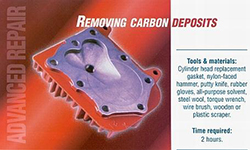
Using unleaded gasoline reduces carbon build upwardly. As a part of regular small engine maintenance, you should still remove the cylinder each 100 hours of functioning and scrape off the carbon, using the tools and solvents described in this section. Clean the cylinder more oftentimes if you use your engine heavily.
![]()
Warning: E'er read the engine and equipment manual(s) before starting, operating, or servicing your engine or equipment to avoid personal injury or property impairment. Encounter an authorized dealer or contact Briggs & Stratton if you are unsure of any procedure or have boosted questions. Find all Engine Safety Warnings.
Utilize the guide below to learn how to clean and remove carbon buildup on the cylinder head, pistons, cylinder wall, and small engine valves. You can jump down to the virtually relevant department with the links beneath.
Removing Engine Components for Cleaning
Removing Carbon Build Up
Re-assembling The Cylinder Caput
Removing Engine Components for Cleaning
The start stride in cleaning the cylinder head is getting access to the cylinder caput. You lot may need to remove some other components get-go.
- Unhook the spark plug wire and secure it, removing any batteries if equipped.
- Remove the muffler, muffler guard and whatever other components that cake access to the cylinder.
- Cylinder head bolts near the muffler and exhaust port may exist longer. To avoid defoliation, prepare a template. Draw a rough outline of the cylinder head on a piece of cardboard and punch holes for each commodities location. And so, remove the cylinder caput bolts and insert them in the respective holes.
- Remove each cylinder head bolt and store it in its respective slot in the paper-thin until you are fix to reinstall the cylinder caput.
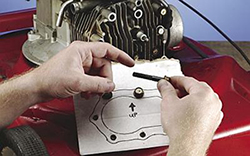
5. Elevator off the cylinder head. If the head sticks, strike it on the side with a nylon-faced hammer. This should loosen the cylinder head enough for your to gently lift if off the engine.NOTE: Do non pry off the cylinder head. This tin damage the surface of the engine cake or the cylinder caput.
6. Remove and discard the old head gasket.
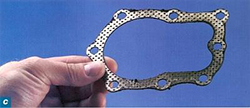
Removing Carbon Buildup
Always wear protective eyewear and solvent-proof gloves when removing carbon. Enquire your Authorized Briggs & Stratton Dealer to recommend an all-purpose solvent that will not harm aluminum or plastic components or leave unwanted residues.
i. Place the piston at the summit dead center and then that the valves are closed. Then, scrape carbon gently from the cylinder head, using a wooden or plastic scraper. Take intendance not to dig the scraper into the aluminum. On stubborn deposits, utilize a putty knife, wire brush or steel wool, taking care not to carry downwardly on the metal surfaces.
2. Make clean away the remaining carbon with solvent, using fine steel wool to smooth crude spots. You can as well soak metal parts for up to xv minutes to remove stubborn deposits. Scrape over again, if necessary, to loosen stubborn grit. And so, clean the area thoroughly with the solvent and prepare the head aside.
With the piston however at the top of the cylinder and the valves closed, utilise the same method to remove carbon deposits from the piston and the cease of the cylinder.
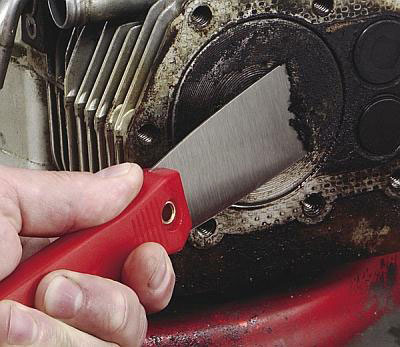
three. Turn the crankshaft to open each valve, and carefully remove whatsoever visible carbon deposits on the valves and valve seats, using only a brass wire brush.
CAUTION: Exercise not allow grit to fall into the valve chambers or between the piston and the cylinder wall.
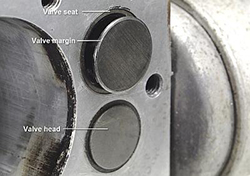
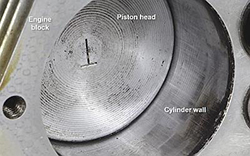
4. Inspect the valves and valve seats to run across if they are cracked, rough or warped. Bring damaged parts to an authorized service dealer for inspection earlier reassembling the head.
5. Using a scraper, solvent or both, remove whatsoever remaining carbon and residue left behind by the caput gasket on the cylinder head and engine block. Make clean the surfaces thoroughly earlier installing the new head gasket. Whatever droppings or oil left on the cylinder head or engine cake may prevent a tight seal and cause eventual engine impairment.
Re-assembling the Cylinder Caput
i. Inspect the surfaces of the engine block, cylinder head and new head gasket to be sure they are clean.
2. Identify the new head gasket in position on the engine block. Do not utilise sealing compounds.
3. Set up the cylinder head on the head gasket, aligning the cylinder caput with the gasket and the engine block.
4. Remove each head bolt from its slot in the cardboard template. And so, insert the bolt in its original location, leaving it loose. Insert the other bolts in the aforementioned fashion. Brand sure to attach whatever housings or brackets that are held in place by the head bolts.
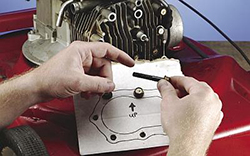
5. Mitt-tighten the head bolts first, without using a wrench.
6. Tighten the cylinder caput bolts in increments, using a torque wrench (service part number 19393). Plow each bolt a few turns, then go along to the next bolt until each bolt is just snug. For final tightening, employ a torque wrench. Proceed in increments or roughly one-3rd the final torque. Consult your small engine transmission for final torque specifications. Avoid tightening a single commodities all the way earlier tightening the other bolts. Uneven tightening is likely to warp the cylinder head.

Source: https://www.briggsandstratton.com/eu/en_gb/support/faqs/browse/removing-carbon-buildup.html

0 Response to "How To Remove Carbon From Exhaust"
Post a Comment